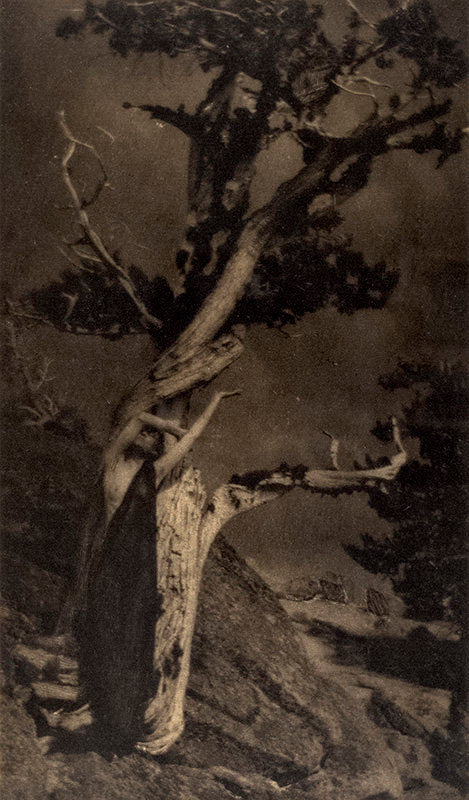
Anne Brigman
The Dying Cedar by Anne Brigman
 Toronto, ON)
Toronto, ON)
Learn about our Shipping & Returns policy.
Have a question? Read our FAQ.
- Artwork Info
- About the Artist
- About This Photograph
- Artist News
-
1909
Photogravure
Published in Camera Work, January 1909, 25:7 -
Born in Hawaii, Anne Brigman (1869 - 1950) moved to California when she was sixteen years old. Trained as a painter, she turned to photography in 1902. "[S]lim, hearty, unaffected women of early maturity living a hardy out-of-door life in high boots and jeans, toughened to wind and sun" were Brigman's favored subjects, and she photographed them nude in the landscape of the Sierra Nevada mountains of Northern California.
Brigman was one of two original California members of the art photography group the Photo-Secession, founded by Alfred Stieglitz, and she was the only Western photographer to be made a Fellow of the group. Three issues of Camera Work featured her photographs, and the British Linked Ring society of photographers elected her a member. Around 1929 she moved to Long Beach in Southern California, where she continued to photograph, focusing on a series of sand erosions. A year before her death in Eagle Rock, near Los Angeles, in 1950, she published a book of her poems and photographs titled Songs of a Pagan.
Source: The J. Paul Getty Museum
-
Brigman's photographs frequently focused on the female nude, dramatically situated in natural landscapes or trees. Many of her photos were taken in the Sierra Nevada in carefully selected locations and featuring elaborately staged poses. Brigman often featured herself as the subject of her images, such as “Soul of the Blasted Pine”, for which she received the Birmingham Photographic Society's first silver medal. Many of her other photos used her sister as the nude model. After shooting the photographs, she would extensively touch up the negatives with paints, pencil, or superimposition.
Brigman's deliberately counter-cultural images suggested bohemianism and female liberation. Her work challenged the establishment's cultural norms and defied convention, instead embracing pagan antiquity. The raw emotional intensity and barbaric strength of her photos contrasted with the carefully calculated and composed images of Stieglitz and other modern photographers.
This photogravure was originally included in a copy of Issue No. 25, January 1909, of Camera Work, Alfred Stieglitz’s ground-breaking photography journal.
-
Anne Brigman, a Pioneering Photographer of Nude Self-Portraits - Artsy, 2018
Photographer Anne Brigman rediscovered in Nevada Museum of Art show - The Art Newspaper, 2018
The feminist history of women artists taking nudes in nature - Dazed, 2018
Anne Brigman, a proto-feminist photographer, gets her due at Nevada Museum - Datebook, 2018
A Century Ago, She Photographed Herself in Nature, Naked and Unafraid - KQED - 2019
Wall to wall: A scholarly exhibition brings a long-forgotten photographer into the present - News Review, 2018

